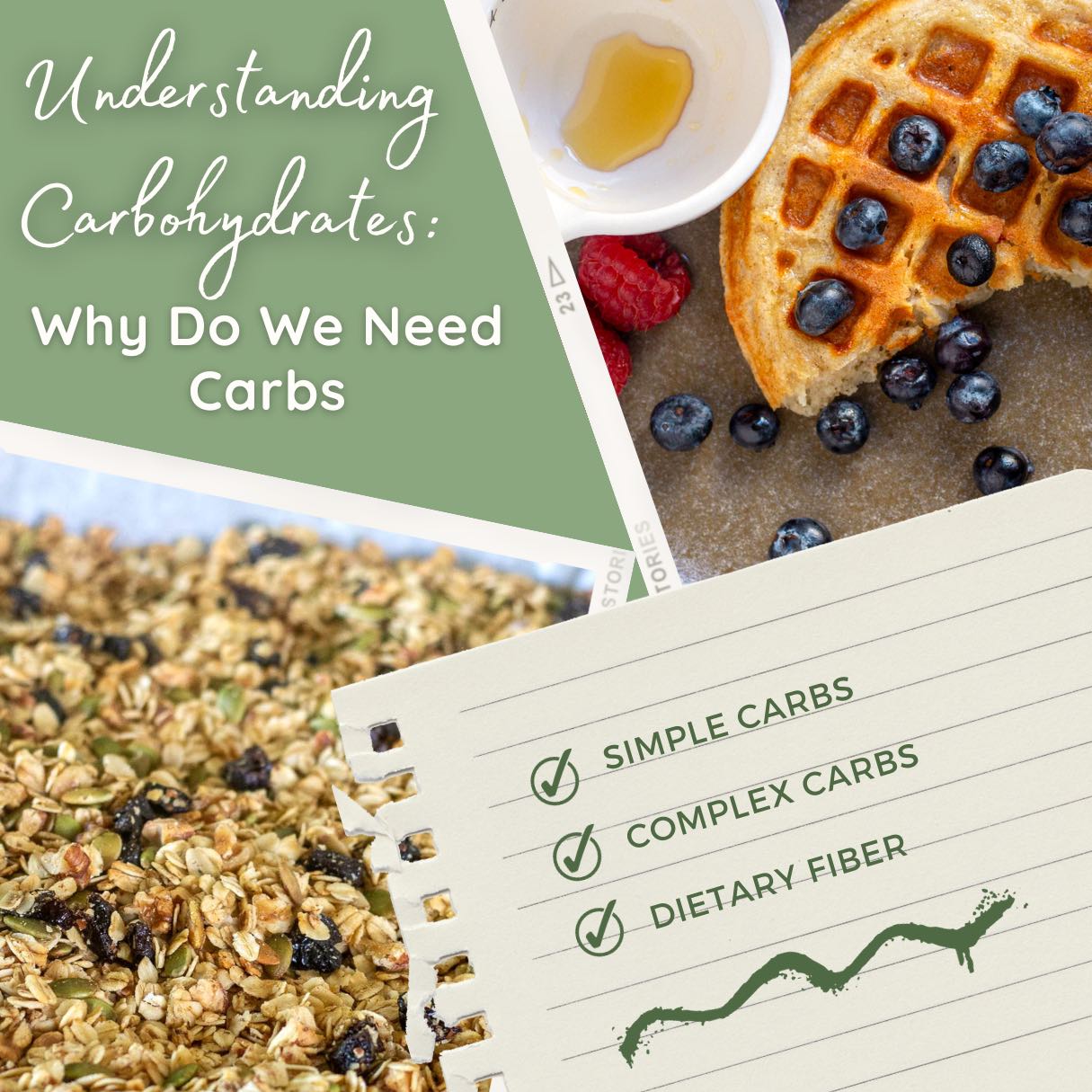Discover the powerhouse behind your energy levels - learn why we need carbs to fuel our body, how to choose the right carbs and understand the glycemic index.

I bet you were at least once involved in a conversation about carbs and their intake. I also bet that you met at least one person claiming that carbs are not good and that we should limit the amount of carbs in our diet. Let me tell you straight, this is plain wrong!
As a former biochemistry professor, I was surprised to see many of my students enlightened to learn that carbs are essential food for our cells. Learning to balance carbohydrate intake is necessary for our well-being.
In this article, I'll explain the importance of carbohydrates as a primary energy source and why the glycemic index is essential. I'll also offer practical tips on balancing your carbs intake and making informed choices to optimize your health and maintain a healthy weight in the long term.
What are Carbohydrates (Carbs)
Our bodies need three main macronutrients to function correctly - carbohydrates, proteins, and fats. In chemical terms, carbohydrates consist of hydrogen, carbon, and oxygen atoms.
Carbohydrates serve as a primary energy source for the body, especially for our brain and muscles. They are involved in a major metabolic pathway called glycolysis, where dietary carbs are transformed into cellular energy called ATP.
Without ATP, our organs would not be able to function correctly, and we would also not be able to use our muscles, brain power, or even breathe.
Types of Carbohydrates
There are three main types of carbohydrates based on their chemical structure and the way our body processes them:
- Simple Carbohydrates (simple carbs) are composed of one or two sugar molecules quickly absorbed and digested by our bodies. They enter our bloodstream quickly and cause a rapid spike in blood sugar levels. The best example is table sugar (chemically known as sucrose), which consists of two molecules, glucose and fructose. Another example is fructose, found in fruits, and lactose, found in dairy products.
- Complex Carbohydrates - these carbohydrates contain long chains of sugar molecules and, as such, are more challenging to break in our bodies, providing a more sustained release of energy. These are found in legumes, whole grains, veggies, and starchy vegetables such as potatoes.
- Dietary Fiber - our bodies are not made to break these even more complex carbohydrates; their role is to pass through our digestive system, aiding in regular bowel movements. They are found in fruits, vegetables, nuts, seeds, and whole grains.
This list suggests that carbohydrates are essential nutrients and components of major pathways on a cellular level and that the quality and types of carbs we choose to ingest significantly differ in how they are digested and processed.
Choosing complex carbs instead of simple ones offers more nutrients and fiber while maintaining more stable blood glucose levels.

Understanding the Glycemic Index (GI)
When we eat food, as part of our digestive process, ingested carbohydrates are broken down into a simple sugar called glucose, which enters the major glycolysis pathway in our cells to produce cellular energy called ATP.
To enter the glycolysis pathway, this simple sugar glucose must be transported to our cells through our bloodstream. If we eat food rich in simple sugars, it will be much easier for our digestive system to break it down into glucose, so our bloodstream will quickly become rich in glucose, causing a rapid spike.
On the contrary, if we consume foods rich in complex carbs, our digestive system will have a harder time breaking them down into glucose, and their release into the bloodstream will be slower and steady, offering a balanced glucose distribution in our bloodstream.
The Glycemic Index is a simple scale used to measure how quickly the carb-containing food we consume raises blood glucose levels compared to the reference value. The reference food is pure glucose or white bread with a GI value 100. According to the Mayo Clinic, below is the list of low, medium, and high GI-score carbohydrate foods:
- Low GI value (1 - 55) foods - green vegetables, most whole fruits, raw carrots, brown rice, kidney beans, chickpeas, lentils, whole-wheat pasta.
- Medium GI value (56 - 69) foods - sweet corn, bananas, raw pineapple, raisins, cherries, oat breakfast cereals, and multigrain, whole-grain wheat or rye bread.
- High GI value foods (70 and higher) - white rice, white bread and potatoes
I've included a complete list of carbohydrate foods and their GI values here. Remember, the lower the GI level, the better for your health.
Finding a Balance with Carbohydrates
When we understand the types of carbohydrates and their roles in our bodies, balancing consumption to support healthy metabolism becomes easier. It becomes clear that carbohydrates are not our enemy, but on the contrary, the building blocks of a healthy diet or carbs are our friends if you wish.
Here are the tips on how to achieve this balance:
- Choose whole foods - opt for plenty of complex carbohydrates in your diet, such as whole grains, fruits and veggies, and legumes, for a steady release of glucose to your bloodstream. In addition, these unprocessed, whole ingredients are rich in fiber, positively affecting our gut health and aiding in regular bowel movements.
- Minimize the consumption of high glycemic index foods to avoid sudden blood sugar spikes, which always follow with a sugar crash.
- Watch portion size and distribute carbs consumption throughout the day.
- Tailor carbs intake based on your activity levels - if you are performing strenuous activity (running or exercising), your body needs energy (ATP), so your cells are working hard to metabolize glucose into energy, which means that your blood is running low and you need more supply of carbs. But if you spend your afternoon on the couch watching Netflix, you most likely have enough in your bloodstream so you can easily skip that bag of chips. If you disagree with me (which is totally legit 😏), your safest bet is to grab an apple (which has a GI index of 36).
- Opt to eat complex carbs earlier in the day to help you avoid excessive carb intake close to bedtime.
Low-carbohydrate Diet and Keto (Ketogenic) Diet
Various dietary approaches promote limiting carb intake, and two popular ones are the low-carb diet and the ketogenic diet. There are similarities between the two, with both advising to limit the amount of carbs in your diet. The main differentiator is how they approach the purpose of carbohydrate limitation.
A low-carb diet often limits refined and processed sugars while allowing moderate consumption of carbs from veggies, fruits, whole grains, and nuts. The aim is to moderate the blood glucose levels and to promote weight loss.
A ketogenic diet is a highly low-carb and high-fat diet that aims to lower the amount of glucose in the bloodstream and shift the metabolic pathway from glycolysis to ketosis, where fat instead of carbs are used as primary energy sources. This diet was developed in the 1920s as a treatment for epilepsy but evolved into a widely accepted weight-loss diet.
Wrapping Up
To breathe, think, and move around, and for all our organs to work correctly, we need healthy carbs. Complex or simple, they get broken down into glucose, an essential compound that enters the natural metabolic pathway called glycolysis to produce much-needed energy.
So, carbohydrates are not to be feared but understood and consumed wisely. Choosing high-quality, nutrient-rich dietary carbohydrate sources while being mindful of portions and timing can harness their immense benefits for sustained energy, optimal organ function, and overall well-being.
So, next time you hear the phrase that you should stay away from carbs, don't run away! Just make sure to choose healthy carbohydrates for the most health benefits, and remember that the type of carbohydrates matters.
Quick Tip!
Instead of opting for a piece of cake (most likely made with table sugar, a simple sugar that releases glucose quickly to our bloodstream, causing a big spike), reach out for the piece of fruit (which has a lower GI and causes a slower rise in glucose level in our bloodstream).

Here Are Some Healthy Recipes You'll Love
- Power Beet Lemon Juice with Ginger (Juicer Recipe)
- Simple Steps to Make Poached Eggs with Avocado
- How to Make Easy Best Avocado Spread with Feta
- 10-ingredient Easy and Healthy Homemade Granola
- Easy Banana Blueberry Muffins with Chocolate Chips
- Easy 10 Minute Strawberry Yogurt Recipe
- Easy Marry Me Chicken Pasta (No Flour Recipe)
- Easy Overnight Chia Seed Pudding with Fruit
Get In Touch!
Are you a fan of healthy and delicious recipes like this one? Stay tuned for more culinary inspiration, nutrition tips, and wellness guides here. Subscribe to the newsletter and follow me on social media to never miss an update! Remember to share your healthy cooking adventures with me in the comments below.






Comments
No Comments